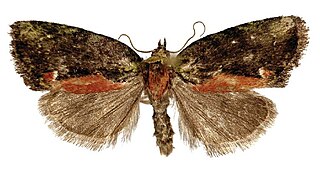
The Noctuidae, commonly known as owlet moths, cutworms or armyworms, are a family of moths. They are considered the most controversial family in the superfamily Noctuoidea because many of the clades are constantly changing, along with the other families of the Noctuoidea. It was considered the largest family in Lepidoptera for a long time, but after regrouping Lymantriinae, Catocalinae and Calpinae within the family Erebidae, the latter holds this title now. Currently, Noctuidae is the second largest family in Noctuoidea, with about 1,089 genera and 11,772 species. This classification is still contingent, as more changes continue to appear between Noctuidae and Erebidae.

The Noctuinae are a subfamily of the family Noctuidae, and is composed of moths. The larvae of many species feed on roots or stems of various grasses. Some are generalist feeders which makes them potential pests.

Tramea is a genus of dragonflies in the family Libellulidae, the skimmers and perchers. Species of Tramea are found in tropical and subtropical regions around the globe. They typically have colored bases to their otherwise translucent hindwings. In particular when they fly, this creates the impression of their carrying bags at the start of their abdomens. They are known commonly as saddlebags or saddlebags gliders.

Bryophilinae is a subfamily of moths in the family Noctuidae. The subfamily was erected by Achille Guenée in 1852.

Mythimna separata, the northern armyworm, oriental armyworm or rice ear-cutting caterpillar, is a moth of the family Noctuidae. It is found in China, Japan, South-east Asia, India, eastern Australia, New Zealand, and some Pacific islands. It is one of the major pests of maize in Asia. The species was first described by Francis Walker in 1865.

Stenoloba is an East Asian genus of moths of the family Noctuidae. The genus was described by Staudinger in 1892.

Agrotis fatidica is a moth of the family Noctuidae. It is found in Southern and Central Europe, east through Russia to Mongolia, China and Tibet.

Feliniopsis leucostigma is a moth of the family Noctuidae. It is found in Sikkim and Darjeeling and has recently been recorded from China.

Trisuloides is a genus of moths of the family Noctuidae.

Heliothinae is a small, cosmopolitan subfamily of moths in the family Noctuidae, with about 400 described species worldwide. It includes a number of economically significant agricultural pest species, such as Helicoverpa armigera and Helicoverpa zea.

The Erebidae are a family of moths in the superfamily Noctuoidea. The family is among the largest families of moths by species count and contains a wide variety of well-known macromoth groups. The family includes the underwings (Catocala); litter moths (Herminiinae); tiger, lichen, and wasp moths (Arctiinae); tussock moths (Lymantriinae), including the arctic woolly bear moth ; piercing moths ; micronoctuoid moths (Micronoctuini); snout moths (Hypeninae); and zales, though many of these common names can also refer to moths outside the Erebidae. Some of the erebid moths are called owlets.

Stenoloba nigrabasalis is a species of moth of the family Noctuidae. It is found in Taiwan.

Stenoloba olivacea is a species of moth of the family Noctuidae. It is found in Taiwan.
Harutaeographa stenoptera is a moth of the family Noctuidae. It is found in Russia, Korea and China (Shaanxi).
Trisuloides becheri is a moth of the family Noctuidae. It is found in China (Shaanxi).

Stenoloba solaris is a moth of the family Noctuidae. It is found in China (Yunnan)

Stenoloba albistriata is a moth of the family Noctuidae. It is found in northern Vietnam.

Stenoloba albistriata is a moth of the family Noctuidae first described by László Aladár Ronkay in 2011. It is found in northern Vietnam.
Catocala seibaldi is a moth in the family Erebidae. It is found in China (Shaanxi).

Tramea stenoloba, the narrow-lobed glider, is a species of dragonfly in the Libellulidae family. It is found in the Cocos Islands, Lesser Sunda Islands, Java Sea and Australia.
















